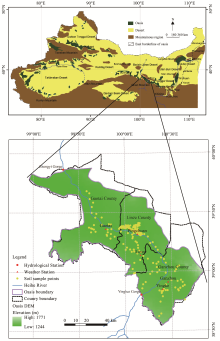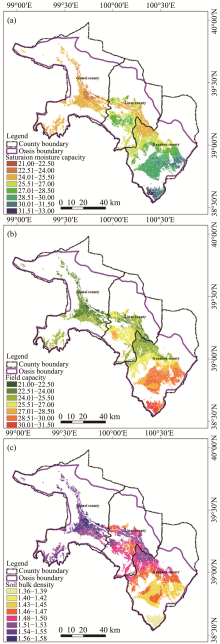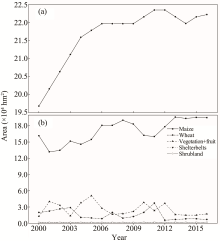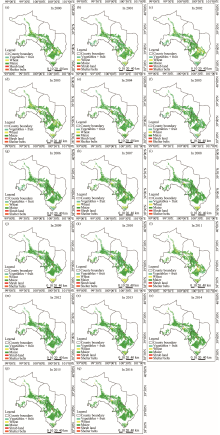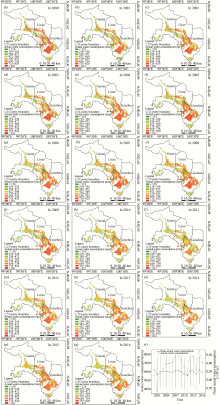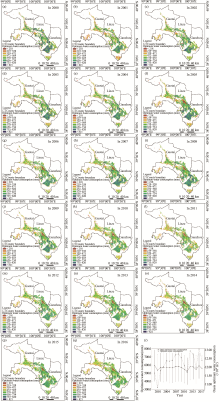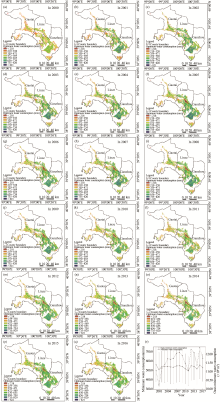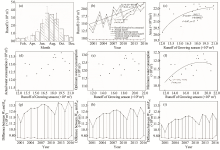Sciences in Cold and Arid Regions ›› 2020, Vol. 12 ›› Issue (4): 217–233.doi: 10.3724/SP.J.1226.2020.00217
• • 上一篇
Assessing spatial and temporal variability in water consumption and the maintainability oasis maximum area in an oasis region of Northwestern China
XueXiang Chang1( ),WenZhi Zhao1(
),WenZhi Zhao1( ),XueLi Chang2,Bing Liu1,Jun Du1
),XueLi Chang2,Bing Liu1,Jun Du1
- 1.Northwest Institute of Eco-Environment and Resources, Chinese Academy of Sciences, Linze Inland River Basin Research Station, Key Laboratory of Ecohydrology of Inland River Basin, CAS, Lanzhou, Gansu 730000, China
2.School of Natural Resources and Environmental Engineering, Ludong University, Yantai, Shandong 264025, China
|
Allen RG, 2000. Using the FAO-56 dual crop coefficient method over an irrigated region as part of an evapotranspiration intercomparison study. Journal of Hydrology, 229: 27-41. DOI: 10.1016/S0022-1694(99)00194-8.
doi: 10.1016/S0022-1694(99)00194-8 |
|
|
Bai E, Li S, Xu W, et al., 2013. A meta-analysis of experimental warming effects on terrestrial nitrogen pools and dynamics. New Phytologist, 199: 441-451. DOI: 10.1111/nph. 12252.
doi: 10.1111/nph. 12252 |
|
|
Campos I, Neale CMU, Suyker AE, et al., 2017. Reflectance-based crop coefficients REDUX: For operational evapotranspiration estimates in the age of high producing hybrid varieties. Agricultural Water Management, 187: 140-153. DOI: 10.1016/j.agwat.2017.03.022.
doi: 10.1016/j.agwat.2017.03.022 |
|
|
Chang X, Liu B, Liu H, et al., 2015a. Water accounting for conjunctive groundwater and surface water irrigation sources: A case study in the middle Heihe River Basin of arid northwestern China. Sciences in Cold and Arid Regions, 7(6): 0687-0701. DOI: 10.3724/SP.J.1226.2015.00687.
doi: 10.3724/SP.J.1226.2015.00687 |
|
| Chang X, Zhao W, Zeng F, 2015b. Crop evapotranspiration-based irrigation management during the growing season in the arid region of northwestern China. Environmental Monitoring and Assessment, 187: 699. | |
|
Chen YN, Ye ZX, Shen YJ, 2011. Desiccation of the Tarim River, Xinjiang, China, and mitigation strategy. Quaternary International, 244 (2): 264-271. DOI: 10.1016/j.quaint.2011. 01.039.
doi: 10.1016/j.quaint.2011. 01.039 |
|
|
Cheng G, Li X, Zhao W, et al., 2014. Integrated study of the water-ecosystem-economy in the Heihe River Basin. National Science Review, 1(3): 413-428. DOI: 10.1093/nsr/nwu017.
doi: 10.1093/nsr/nwu017 |
|
|
Cruz-Blanco M, Gavilán P, Santos C, et al., 2014. Assessment of reference evapotranspiration using remote sensing and forecasting tools under semi-arid conditions. International Journal of Applied Earth Observation and Geoinformation, 33: 280-289. DOI: 10.1016/j.jag.2014.06.008.
doi: 10.1016/j.jag.2014.06.008 |
|
| Goovaerts P, 1997. Geostatistics for Natural Resources Evaluation. Oxford University Press, New York, pp. 259-368. | |
|
Gurevitch J, Morrow LL, Wallace A, et al., 1992. A meta-analysis of competition in field experiments. American Naturalist, 140: 539-572. DOI: 10.1086/285428.
doi: 10.1086/285428 |
|
| Hafeez M, Khan S, 2005. Remote sensing application for estimation of irrigation water consumption in liuyuankou irrigation system in China. In: Proceedings 16th Congress of the Modelling and Simulation Society of Australia and New Zealand, pp. 12-15. | |
| Han DL, 1999. The progress of research on oasis in China. Scientia Geographica Sinica, 19(4): 313-319. | |
|
Hedges LV, Gurevitch J, Curtis PS, 1999. The meta-analysis of response ratios in experimental ecology. Ecology, 80: 1150-1156. DOI: 10.1890/0012-9658.
doi: 10.1890/0012-9658 |
|
| Huang Z, Shen W, 2000. Water Relationship and Drought Tolerance of Plants in Arid Areas. Beijing: China Environment Press. | |
| Jia B, Ren Y, Yang J, 2001. Theoretical thinking on the ecological construction of oasis landscape. Journal of Arid Land Resources and Environment, 15(1): 56-63. | |
|
Ko J, Piccinni G, 2009. Corn yield responses under crop evapotranspiration-based irrigation management. Agricultural Water Management, 96: 799-808. DOI: 10.1016/j.agwat.2008.10.010.
doi: 10.1016/j.agwat.2008.10.010 |
|
|
Li X, Yang K, Zhou Y, 2016. Progress in the study of oasis-desert interactions. Agricultural Forest Meteorology, 230-231: 1-7. DOI: 10.1016/j.agrformet.2016.08.022.
doi: 10.1016/j.agrformet.2016.08.022 |
|
|
Li Y, Huang C, Hou J, et al., 2017. Mapping daily evapotranspiration based on spatiotemporal fusion of ASTER and MODIS images over irrigated agricultural areas in the Heihe River Basin, Northwest China. Agricultural Forest Meteorology, 244-245: 82-97. DOI: 10.1016/j.agrformet.2017. 05.023.
doi: 10.1016/j.agrformet.2017. 05.023 |
|
|
Ling HB, Xu HL, Fu JY, 2013. High- and low-flow variations in annual runoff and their response to climate change in the headstreams of the Tarim River, Xinjiang, China. Hydrological Processes, 27: 975-988. DOI: 10.1002/hyp.9274.
doi: 10.1002/hyp.9274 |
|
| Liu G, 1996. Standard Methods for Observation and Analysis in Chinese Ecosystem Research Network: Soil Physical and Chemical Analysis & Description of Soil Profiles. China Standards Press: Beijing, China. | |
|
Oki T, Kanae S, 2006. Global hydrological cycles and world water resources. Science, 313(5790): 1068-1072. DOI: 10.1126/science.1128845.
doi: 10.1126/science.1128845 |
|
|
Payero JO, Tarkalson DD, Irmak S, et al., 2008. Effect of irrigation amounts applied with subsurface drip irrigation on corn evapotranspiration, yield, water use efficiency, and dry matter production in a semiarid climate. Agricultural Water Management, 95: 895-908. DOI: 10.1016/j.agwat. 2008.02.015.
doi: 10.1016/j.agwat. 2008.02.015 |
|
|
Rana G, Katerji N, 2000. Measurement and estimation of actual evapotranspiration in the field under Mediterranean climate: a review. European Journal of Agronomy, 13: 125-153. DOI: 10.1016/S1161-0301(00)00070-8.
doi: 10.1016/S1161-0301(00)00070-8 |
|
| Su P, Du M, Zhao A, et al., 2002. Study on water requirement law of some crops and different planting mode in oasis. Agricultural Research in the Arid Areas, 20(2): 79-85. | |
|
Tang QH, Peterson S, Cuenca RH, et al., 2009. Satellite-based near-real-time estimation of irrigated crop water consumption. Journal of Geophysical Research, 114: D05114. DOI: 10.1029/2008JD010854.
doi: 10.1029/2008JD010854 |
|
|
Toureiro C, Serralheiro R, Shahidian S, et al., 2017. Irrigation management with remote sensing: Evaluating irrigation requirement for maize under Mediterranean climate condition. Agricultural Water Management, 184: 211-220. DOI: 10.1016/j.agwat.2016.02.010.
doi: 10.1016/j.agwat.2016.02.010 |
|
|
Velpuri NM, Senay GB, Singh RK, et al., 2013. A comprehensive evaluation of two MODIS evapotranspiration products over the conterminous United States: Using point and gridded FLUXNET and water balance ET. Remote Sensing of Environment, 139: 35-49. DOI: 10.1016/j.rse.2013.07.013.
doi: 10.1016/j.rse.2013.07.013 |
|
| Wang J, Chang X, 2013. Change trend of the groundwater depth in Linze county in the middle reaches of Heihe River basin in recent 30 years. Arid Zone Research, 30(4): 594-602. | |
|
Wang X, Taub DR, 2010. Interactive effects of elevated carbon dioxide and environmental stresses on root mass fraction in plants: a meta-analytical synthesis using pairwise techniques. Oecologia, 163(1): 1-11. DOI: 10.1007/s00442-010-1572-x.
doi: 10.1007/s00442-010-1572-x |
|
|
Zhang M, Wang S, Fu B, et al., 2018. Ecological effects and potential risks of the water diversion project in the Heihe River Basin. Science of the Total Environment, 619-620: 794-803. DOI: 10.1016/j.scitotenv.2017.11.037.
doi: 10.1016/j.scitotenv.2017.11.037 |
|
|
Zhao W, Chang X, Chang X, et al., 2018. Estimating water consumption based on meta-analysis and MODIS data for an oasis region in northwestern China. Agricultural Water Management, 208: 478-489. DOI: 10.1016/j.agwat.2018. 06.035.
doi: 10.1016/j.agwat.2018. 06.035 |
|
|
Zhao W, Liu B, Zhang Z, 2010. Water requirements of maize in the middle Heihe River basin, China. Agricultural Water Management, 97: 215-223. DOI: 10.1016/j.agwat.2009. 09.011.
doi: 10.1016/j.agwat.2009. 09.011 |
| No related articles found! |
|
||

